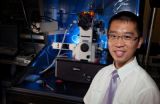(Press-News.org) TALLAHASSEE, Fla. -- Florida State University researchers led by physics doctoral student Campion Loong have achieved significant benchmarks in a study of the human cardiac protein alpha-tropomyosin, which is an essential, molecular-level component that controls the heart's contraction on every beat.
Using an imaging method called atomic force microscopy, Loong achieved two "firsts": the first direct imaging of individual alpha-tropomyosin molecules, which are very small — roughly 40 nanometers long — and the first demonstrated examples of a measure of the human cardiac protein's flexibility. From there, he established a baseline of how flexible a normal version of the protein is supposed to be in a healthy human heart.
"This basic research is important to broadening our understanding of how the human heart functions normally at the molecular level," Loong said. "The flexibility of alpha-tropomyosin dictates how effectively or properly the heart muscle will contract on each beat and has implications for keeping the heart free of cardiovascular disease.
"Before this study, we did not know how flexible this protein was," Loong said. "Using these results, now we can conduct subsequent studies to compare disease-related mutants of this protein to see how much they deviate from normal versions."
Loong served as the lead author of the paper "Persistence Length of Human Cardiac a-Tropomyosin Measured by Single Molecule Direct Probe Microscopy," which was published in the journal PLoS ONE. He conducted the research with physics Professor Huan-Xiang Zhou and biological science Professor P. Bryant Chase, both of Florida State.
When an electrical signal is generated in the heart to make it contract, calcium is released inside each heart muscle cell. The calcium then binds to a protein called troponin, and that triggers the "flexing movement" of alpha-tropomyosin, which allows another protein called myosin — the motor protein — to interact with the troponin/tropomyosin actin filaments. This series of events is what generates the heart's contraction that pumps blood. A subsequent removal of calcium inside each heart cell is what relaxes the heart, which allows the heart to fill with blood to be pumped on the next beat.
"Alpha-tropomyosin is a key element that makes the calcium signal either turn the heart on, making it contract, or turn it off, making it relax," Chase said. "There is an optimal range of flexibility of alpha-tropomyosin for the normal heart to function properly. The molecule can be too stiff or it can be too flexible, either of which could lead to cardiovascular disease. What we ultimately think is that evolution has tuned the mechanical properties of these proteins for optimal function in the heart."
INFORMATION:
Research yields two 'firsts' regarding protein crucial to human cardiac function
2012-08-31
ELSE PRESS RELEASES FROM THIS DATE:
BUSM researchers study use of MRI in osteoarthritis
2012-08-31
(Boston) – A study conducted by researchers at Boston University School of Medicine (BUSM) shows that magnetic resonance imaging (MRI) detected a high prevalence of abnormalities associated with knee osteoarthritis in middle-aged and elderly patients that had no evidence of knee osteoarthritis in X-ray images.
Ali Guermazi, MD, PhD, professor of radiology at BUSM and chief of Musculoskeletal Imaging at Boston Medical Center (BMC), led this study in collaboration with researchers from Lund University in Sweden, Brigham and Women's Hospital in Boston and Klinikum Augsburg ...
BUSM researchers find potential key to halt progression, reverse damage from emphysema
2012-08-31
(Boston) – A study led by researchers at Boston University School of Medicine (BUSM) has shown that a compound used in some skin creams may halt the progression of emphysema and reverse some of the damage caused by the disease. When the compound Gly-His-Lys (GHK) was applied to lung cells from patients with emphysema, normal gene activity in altered cells was restored and damaged aspects of cellular function were repaired.
The study, which is published in BioMed Central's open access journal Genome Medicine, also demonstrates the potential impact of using genomic technologies ...
Mobile apps for diabetes present usability issues for older adults
2012-08-31
Diabetes is prevalent among adults aged 65 and older and can lead to a number of other serious health issues. Maintaining control of blood glucose levels is one of the most important actions diabetics can take to control their illness. New technology is designed to make self-monitoring easier and more accessible than ever before, but often tech products fail to accommodate some older users. Human factors/ergonomics researchers Laura A. Whitlock and Anne Collins McLaughlin evaluated the usability issues that older adults may experience with one type of emerging technology, ...
Wayne State researchers say adolescent smoking prevention programs still critical
2012-08-31
DETROIT — While many might see the case for programs to prevent adolescent cigarette smoking as already made, a pair of Wayne State University researchers believes that due to increasingly challenging economic times, policymakers need to be reminded to continue allocating funding for such programs.
Xinguang Chen, M.D., Ph.D., professor of pediatrics in the School of Medicine, and Feng Lin, Ph.D., professor of electrical and computer engineering in the College of Engineering, have found a way to provide policymakers with some hard evidence.
Most adult smokers in the ...
AGU journal highlights -- 31 August 2012
2012-08-31
The following highlights summarize research papers that have been recently
published in Geophysical Research Letters (GRL), Journal of Geophysical
Research - Biogeosciences (JGR-G), Journal of Geophysical Research -
Atmospheres (JGR-D), Water Resources Research (WRR), and Space Weather
(SW).
In this release:
1. Trade-offs between water for food and for curbing climate change
2. Low calcification in corals in the Great Barrier Reef
3. The Everglades still threatened by excess nutrients
4. Wetlands the primary source of Amazon Basin methane
5. Old fractures ...
Cleveland Clinic researchers investigating potential drug for treatment of Alzheimer's disease
2012-08-31
Friday, Aug. 31, 2012, Cleveland: A compound developed to treat neuropathic pain has shown potential as an innovative treatment for Alzheimer's disease, according to a study by researchers at Cleveland Clinic's Lerner Research Institute and Anesthesiology Institute.
"Cleveland Clinic dedicated two years of research into the examination of this compound and our findings show it could represent a novel therapeutic target in the treatment of Alzheimer's disease," said Mohamed Naguib, M.D., Professor of Anesthesiology, Cleveland Clinic Lerner College of Medicine. "Development ...
International collaboration key to science and engineering globalization
2012-08-31
International collaboration is a key aspect of the globalization of science and engineering. A recent report and data evaluation released by the National Science Foundation (NSF) showed that one in six scientists and engineers in the United States reported working with individuals in other countries in a given week. International collaboration was more likely to occur among persons working in the for-profit sector, men, and those with higher levels of educational attainment. Individuals who earned postsecondary degrees both in the United States and abroad reported the highest ...
Customer service is an emotional experience
2012-08-31
Los Angeles, (August 31, 2012) You can probably recall a customer service experience that left you feeling good. A recent study has shown not only that positive emotion from sales staff is contagious to a customer, but that a satisfied customer also improves the salesperson's mood. This research is now available in Human Relations, published by SAGE.
Sandra Kiffin-Petersen, and Geoffrey Soutar from University of Western Australia and Steven Murphy from Carlton University, Canada used a qualitative diary study with 276 sales employees to shed light on the sales experience ...
Intervention helps children with sickle cell disease complete MRI tests without sedation
2012-08-31
Sitting still is tough for children, which makes MRI scans a challenge. The scans require that patients remain motionless for extended periods. Findings from St. Jude Children's Research Hospital showed that a brief, targeted intervention dramatically increases the likelihood that children as young as 5 years old will be able to undergo testing without sedation.
That is good news for children with sickle cell disease, who were the focus of this study. Patients with sickle cell disease often undergo brain and liver MRIs to check for complications related to their disease ...
Early activation of immune response could lead to better vaccines
2012-08-31
August 30, 2012 — (Bronx, NY) — Researchers at Albert Einstein College of Medicine of Yeshiva University have discovered a new "first response" mechanism that the immune system uses to respond to infection. The findings challenge the current understanding of immunity and could lead to new strategies for boosting effectiveness of all vaccines. The study, conducted in mice, published online today in the journal Immunity.
Grégoire Lauvau, Ph.D.One way the immune system protects the body against microbes like bacteria and viruses is with memory CD8+ T cells, so named because ...


